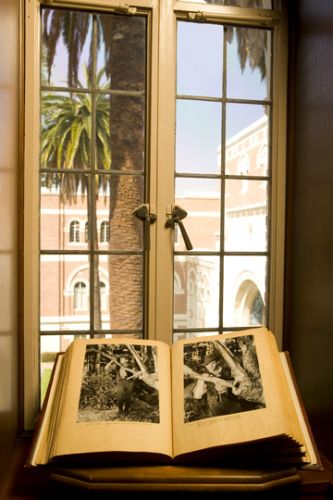
The latest USC Libraries’ acquisition related to the 1935 film version of A Midsummer Night’s Dreamis a limited-run scrapbook. Photo: John Livzey
The USC News website recently featured the libraries' Max Reinhardt Collection. Reinhardt (1873-1943) was an Austrian (and later American) theater and film director who was influential in developing the idea of the director as auteur. In 1934, he staged a famous production of William Shakespeare's A Midsummer Night's Dream at the Hollywood Bowl and later directed a film version for Warner Bros. As Dan Knapp explains in his article, the Reinhard collection, as well as many other materials held by the libraries, give valuable insight into these productions:
A Dream Collection for Cinephiles
By Dan KnappAfter noted theatre director Max Reinhardt fled World War II Germany in 1933, he made his way to Los Angeles, where he mounted his legendary production of A Midsummer Night’s Dream at the Hollywood Bowl.
Based on the popularity and critical acclaim of the outdoor production, Warner Bros. signed the émigré to adapt the play to film.
When Reinhardt’s interpretation of A Midsummer Night’s Dream landed in movie theatres in October 1935, it was Hollywood’s first cinematic Shakespearean adaptation since Douglas Fairbanks and Mary Pickford’s 1929 version of Taming of the Shrew.
Perhaps best remembered for its stellar cast that included James Cagney as Bottom, Victor Jory as Oberon, Jean Muir as Helena, Dick Powell as Lysander and a 15-year-old Mickey Rooney as Puck, the film — though not a blockbuster success when released — is notable for several milestones.
Reinhardt’s version of the tale featured the first film score written by Viennese opera composer Erich Wolfgang Korngold, who based the music on Felix Mendelssohn’s 1843 music for the play.
The film also was the screen debut of future Academy Award nominee Olivia de Havilland. Reinhardt had seen the actress in a Mills College production of A Midsummer Night’s Dream and cast her in his Hollywood Bowl production.
Reinhardt was so impressed by the unknown ingénue’s interpretation of the role of Hermia, he insisted that she play the part in the movie.
When the film debuted, moviegoers were mesmerized by its surreal visual elements.
Cinematographer Hal Mohr meticulously constructed an otherworldly vision for the black-and-white film. He painted the shadowed forest in shades of orange and brown, while covering the trees in thick coats of shiny aluminum paint to reflect light.
Mohr’s technique gave Shakespeare’s fairies a luminous landscape in which to frolic. For his effort, Mohr became the first and only person in Oscar history to win through a write-in vote after he was left off the initial balloting due to a Hollywood labor dispute.
The USC Libraries holds a wealth of items relating to this chapter in Hollywood history.
Following Reinhardt’s death in 1943, the USC Libraries obtained a portion of the auteur’s personal library.
The USC Libraries also owns original images taken by Los Angeles photographer Dick Whittington during the celebrated run of A Midsummer Night’s Dream at the Bowl in the early 1930s.
Within the USC Cinematic Arts Library and the USC-administered Warner Bros. archive are Korngold’s original handwritten scores, photos, video and audio clips and correspondence with studio heads.
Finally, the latest acquisition related to the 1935 film version of Shakespeare’s story is a limited-run scrapbook produced for individuals such as studio head Jack Warner. The leather-bound scrapbook contains more than 200 original black-and-white glossy photos from the film along with scene descriptions below each picture and reviews of the film.
Although subsequent versions of A Midsummer Night’s Dream have been filmed — most recently in 1999 with Michelle Pfeiffer and Kevin Kline — the 1935 Reinhardt film remains the definitive version for cinephiles and the USC Libraries’ various collections give film scholars insight into the film’s production.
To view the Reinhart and Whittington collections or the scrapbook, contact USC Libraries’ Special Collections at specol@usc.edu.
For more information on the Korngold-related items, contact the Warner Bros. Archive at wbarchives@cinema.usc.edu or the USC Cinematic Arts Library at cin@usc.edu.

A close-up of the scrapbook. Photo: John Livzey